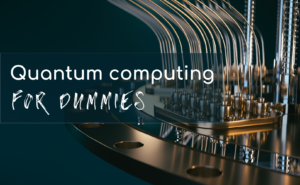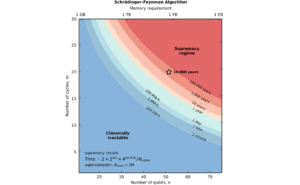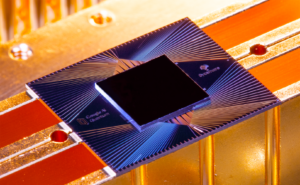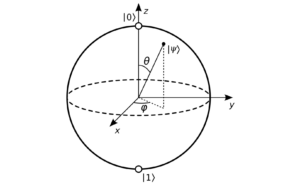
Quantum computing for dummies is an essential guide for beginners to understand the complex world of quantum technology. This article answers key questions such as: What is quantum computing? How does it work? Why is it important? We will also discuss its fundamental element, the qubit, and the quantum phenomena that make quantum computing possible. If you wish to learn more about quantum, check our catalogue full of educational resources!
Introduction to Quantum Computing for Dummies – A Simple Guide
We all know what a computer is; we use it in our daily lives in many of its multiple versions: desktop, laptop, mobile phone, tablet, etc. What they all have in common is their way of processing information. All of it goes through the device’s processor, which is essentially a giant set of interconnected nanoscopic transistors. Each of these transistors represents a bit, which, as we know, is the fundamental unit of computing. If the transistor allows current to pass, it is interpreted as a 1, and if not, as a 0.
Transistors and processors have been and continue to be very useful for innumerable tasks and problems. However, no matter how many millions of transistors a processor may have, there are problems in the world whose complexity grows so rapidly, exponentially with each degree of difficulty, that no processor would be capable of tackling them.
For example, a graph consists of a series of points connected by lines. If I want all the points in the graph to be connected, each additional point will be more costly than the previous one. The first point is free, the second one costs one line, the third costs two lines, the fourth three lines, and so on. This seemingly simple process can become very complex when we think on a large scale, such as a social network. Under the same conditions we have described, adding a new user could require hundreds of millions of new connections.
Additionally, we cannot make transistors as small as we would like because, upon reaching a certain scale, quantum effects appear, causing them to behave strangely and leading to faults in the processor.
It is in these situations, along with many others, that quantum computing makes sense. The elementary unit of information it is based on, the qubit (which is simply a particle or a molecule depending on the type of quantum computer), has a series of quantum properties that allow for handling very large numbers without any cost. This is because the numbers for processing information we can handle increase exponentially with the number of qubits in our quantum processor.
Thus, for the example we discussed, with just 2 qubits, we could add up to 4 points to our graph, as opposed to the 4 bits we would need in the classical case.
Quantum computing is a revolutionary field that promises to transform the way we process information. If you’ve ever wondered, “What is quantum computing?”, this article is for you. We’ll break down the basics and explore the fascinating potential of quantum technology.
What is Quantum Computing?
Quantum Computing is the science field resulting from the intersection of quantum mechanics and computation. It uses the principles of quantum mechanics to perform calculations in its processor, which is designed to handle quantum elements. Unlike classical computers, which use bits as the smallest unit of data (either a 0 or a 1), quantum computers use quantum bits or qubits. These qubits can exist in multiple states simultaneously, thanks to a phenomenon known as superposition.
Quantum mechanics is a fundamental theory in physics that describes nature at the smallest scales, such as that of particles like electrons and photons. Quantum mechanics introduces concepts that are quite foreign to our everyday experience, such as superposition, entanglement, and quantum interference, which formed the basis for quantum computing.
What is Quantum Computing and Why is it Important?
Understanding what quantum computing is and why it is important involves looking at its potential impact. Quantum computers could revolutionise fields such as cryptography, material science, and drug discovery by solving problems that are currently intractable for classical computers. For instance, they could break widely used cryptographic codes, discover new pharmaceuticals by simulating molecular structures more accurately, and optimize complex systems like supply chains or financial portfolios.

The star shows the estimated computation time for the largest experimental circuits developed for Google in 2019.
What is Quantum Computing with Examples?
To better understand quantum computing, let’s look at some examples. One of the most famous algorithms is Shor’s algorithm, which can factor large numbers exponentially faster than the best-known classical algorithms. This has profound implications for cryptography, as many encryption systems rely on the difficulty of factoring large numbers. Bank entities, and social media like WhatsApp, Instagram, or Facebook base their cybersecurity on RSA algorithms that could be beaten in minutes or seconds by a sufficiently powerful quantum computer.
Another example is Grover’s algorithm, which provides a quadratic speedup for unsorted database searches. This means that if a classical algorithm needs N operations to find an item in an unsorted database, Grover’s algorithm can find it in roughly sqrt(N) operations, representing a significant efficiency boost. Entities with large databases, such as medical insurance companies, banks, or governments with census data, could benefit significantly from this technology.
What is Quantum Computing Technology?
When we ask, “What is quantum computing technology?”, we refer to the hardware and software that make quantum computing possible. This includes qubits made from various physical systems such as superconducting circuits, trapped ions, and topological qubits, among others. Additionally, specialised quantum algorithms and error-correction techniques are crucial for the practical implementation of quantum computing.
Superconducting circuits are one of the most widely used technologies for qubits. These circuits operate at extremely low temperatures (approximately -272.8 ºC ) and use Josephson junctions (nanostructures of aluminum) to create qubits. Companies like IBM and Google have developed superconducting quantum computers with increasing numbers of qubits.

Sycamore Quantum Processor from Google
Trapped ion quantum computers use ions confined in electromagnetic fields as qubits. This technology has the advantage of relatively long coherence times, allowing for more complex computations.
Topological quantum computation is an approach to storing and manipulating quantum information that employs exotic quasiparticles called anyons. Anyons generalise the statistics of the commonly known bosons and fermions, making them more robust against local disturbances.
Quantum error correction is another crucial aspect of quantum computing technology. Qubits are highly susceptible to errors from environmental noise and decoherence. Quantum error correction techniques, such as the surface code, help protect quantum information and make computations more reliable.
What is Quantum Computing and How Does it Work? ➡️ The Qubit Model
Quantum computers leverage two key principles of quantum mechanics: superposition and entanglement, implemented through its elementary unit, the qubits.
To represent a qubit and become familiar with how to operate it, the Bloch Sphere is often used. This sphere is a 3D representation of the possible values a qubit can take, which goes far beyond 0 or 1. All points on the surface of this sphere represent a possible state between 0 and 1, located at the poles of the sphere.

Bloch Sphere with angles visualization
The Bloch Sphere is a powerful visualization tool. In classical computing, bits are binary and can either be 0 or 1. However, qubits can be in a state represented as a point on the Bloch Sphere, indicating a complex superposition of 0 and 1. The equator of the Bloch Sphere represents states where the qubit is in a perfect superposition, while the poles represent the pure states of 0 and 1.
Quantum computers also utilize quantum gates, the quantum analogue of classical logic gates. These gates manipulate qubits through operations such as the Hadamard gate (which creates superposition) and the CNOT gate (which creates entanglement between qubits). By applying a sequence of these gates, quantum algorithms can be implemented.
Quantum Computing for Dummies – What are The Quantum Phenomena in a Qubit? 💫
As we’ve seen, the qubit is the fundamental unit of quantum computing, and it exhibits quantum characteristics that make it excellent for certain problems. These are primarily superposition, entanglement, and interference. Let’s examine each of them:
- Superposition: In quantum mechanics, superposition allows a qubit to exist in multiple states at the same time. Unlike classical bits, which can be either 0 or 1, a qubit can be in a state that is a combination of both 0 and 1 simultaneously. This property enables quantum computers to perform multiple calculations simultaneously, potentially leading to significant speedups in certain types of computations.
- Entanglement: Entanglement is a phenomenon where the quantum states of two or more qubits become correlated in such a way that the state of one qubit instantaneously affects the state of another, regardless of the distance between them. This allows for the creation of highly interconnected quantum systems, enabling complex computations and communication protocols not possible with classical systems.
- Interference: Interference occurs when the quantum states of qubits interfere with each other, leading to constructive or destructive interference. This property is crucial for quantum algorithms, allowing quantum systems to amplify the probability of obtaining correct results and reduce the probability of obtaining incorrect results through constructive and destructive interference, respectively.
What is quantum computing technology and how to work with Qubits?
To transition from one state to another, one would need to move across the surface of the Bloch Sphere. If we imagine the vector connecting the point on the surface of the sphere with its center, moving from one point to another requires performing a rotation around the desired axis (or axes). That’s essentially what quantum logic gates do—perform these rotations in the space of a qubit, i.e., the Bloch Sphere.
Combining multiple qubits and quantum gates (rotations), quantum circuits are constructed. These are concatenations of operations on the qubits with a specific purpose.
Some common quantum gates include the Hadamard gate, which creates superposition, and the Pauli-X gate, which acts like a classical NOT gate but for qubits. The CNOT gate (controlled-NOT gate) is a two-qubit gate that entangles qubits, making it fundamental for creating entanglement in quantum algorithms.
✔️What is Quantum Computing in Simple Words?
Imagine a computer that can do many calculations at once, thanks to its ability to be in multiple states simultaneously. This is the essence of quantum computing. It holds the promise of performing tasks in seconds that would take today’s supercomputers millions of years.
In simple terms, quantum computing harnesses the strange and powerful properties of quantum mechanics to solve problems currently beyond the reach of classical computers. It’s like having a supercharged version of a computer that can explore many possible solutions to a problem simultaneously rather than one at a time.


